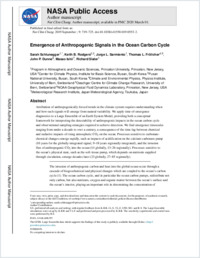Emergence of Anthropogenic Signals in the Ocean Carbon Cycle.
- Schlunegger S Program in Atmospheric and Oceanic Sciences, Princeton University, Princeton, New Jersey, USA.
- Rodgers KB Center for Climate Physics, Institute for Basic Science, Busan, South Korea.
- Sarmiento JL Program in Atmospheric and Oceanic Sciences, Princeton University, Princeton, New Jersey, USA.
- Frölicher TL Climate and Environmental Physics, Physics Institute, University of Bern, Switzerland.
- Dunne JP NOAA Geophysical Fluid Dynamics Laboratory, Princeton, New Jersey, USA.
- Ishii M Meteorological Research Institute, Japan Meteorological Agency, Tsukuba, Japan.
- Slater R Program in Atmospheric and Oceanic Sciences, Princeton University, Princeton, New Jersey, USA.
- 2019-09-20
Published in:
- Nature climate change. - 2019
English
Attribution of anthropogenically-forced trends in the climate system requires understanding when and how such signals will emerge from natural variability. We apply time-of-emergence diagnostics to a Large Ensemble of an Earth System Model, providing both a conceptual framework for interpreting the detectability of anthropogenic impacts in the ocean carbon cycle and observational sampling strategies required to achieve detection. We find emergence timescales ranging from under a decade to over a century, a consequence of the time-lag between chemical and radiative impacts of rising atmospheric CO2 on the ocean. Processes sensitive to carbonate-chemical changes emerge rapidly, such as impacts of acidification on the calcium-carbonate pump (10 years for the globally-integrated signal, 9-18 years regionally-integrated), and the invasion flux of anthropogenic CO2 into the ocean (14 globally, 13-26 regionally). Processes sensitive to the ocean's physical state, such as the soft-tissue pump, which depends on nutrients supplied through circulation, emerge decades later (23 globally, 27-85 regionally).
- Language
-
- English
- Open access status
- green
- Identifiers
-
- DOI 10.1038/s41558-019-0553-2
- PMID 31534491
- Persistent URL
- https://roar.hep-bejune.ch/global/documents/155457
Statistics
Document views: 30
File downloads:
- fulltext.pdf: 0
